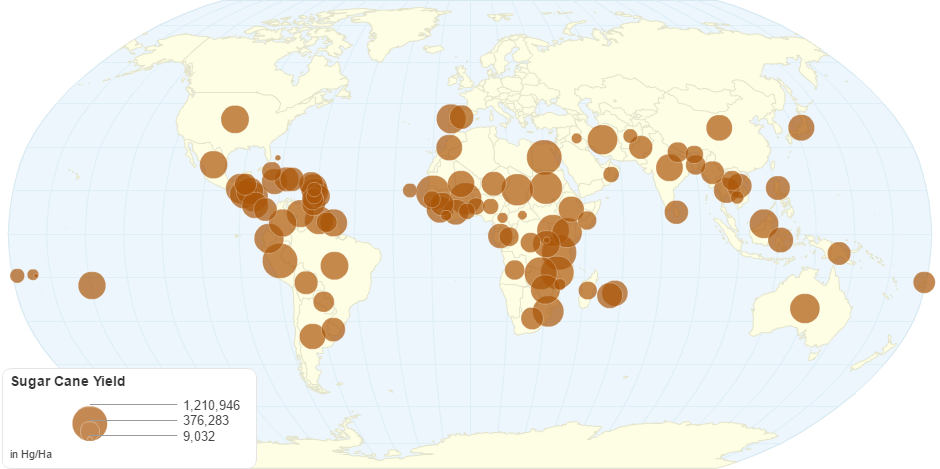This chart shows Sugar Cane Yield by Country.
Sugarcane, or sugar cane, are several species of tall perennial true grasses of the genus Saccharum, tribe Andropogoneae, native to the warm temperate to tropical regions of South Asia and Melanesia, and used for sugar production. It has stout, jointed, fibrous stalks that are rich in the sugar sucrose, which accumulates in the stalk internodes.
The plant is two to six meters tall. All sugar cane species interbreed and the major commercial cultivars are complex hybrids. Sugarcane belongs to the grass family Poaceae, an economically important seed plant family that includes maize, wheat, rice, and sorghum, and many forage crops.Sucrose, extracted and purified in specialized mill factories, is used as raw material in the food industry or is fermented to produce ethanol. Ethanol is produced on a large scale by the Brazilian sugarcane industry.
Sugarcane is the world's largest crop by production quantity. Sugarcane is a tropical, perennial grass that forms lateral shoots at the base to produce multiple stems, typically three to four m high and about 5 cm in diameter. The stems grow into cane stalk, which when mature constitutes around 75% of the entire plant. A mature stalk is typically composed of 11–16% fiber, 12–16% soluble sugars, 2–3% nonsugars, and 63–73% water.
The average yield of cane stalk is 60–70 tonnes per hectare per year. However, this figure can vary between 30 and 180 tonnes per hectare depending on knowledge and crop management approach used in sugarcane cultivation. Sugarcane is a cash crop, but it is also used as livestock fodder.
Sugarcane cultivation requires a tropical or temperate climate, with a minimum of 60 cm of annual moisture. It is one of the most efficient photosynthesizers in the plant kingdom. It is a C4 plant, able to convert up to 1% of incident solar energy into biomass.
Sugarcane can be grown on many soils ranging from highly fertile well-drained mollisols, through heavy cracking vertisols, infertile acid oxisols, peaty histosols, to rocky andisols. Both plentiful sunshine and water supplies increase cane production. This has made desert countries with good irrigation facilities such as Egypt some of the highest-yielding sugarcane-cultivating regions.
9 years ago

